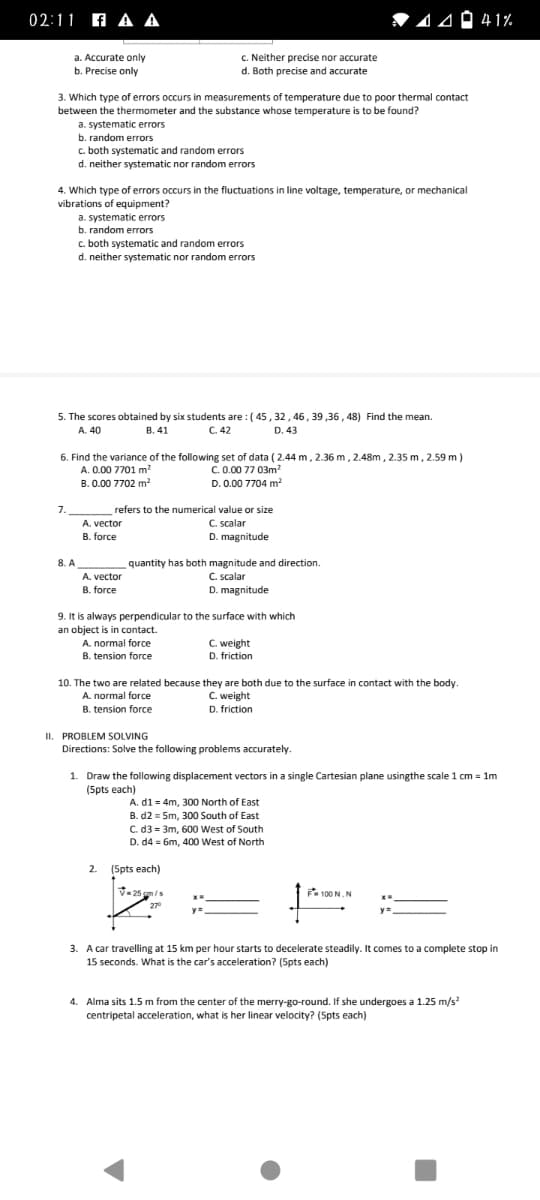a. Accurate only b. Precise only c. Neither precise nor accurate d. Both precise and accurate 3. Which type of errors occurs in measurements of temperature due to poor thermal contact between the thermometer and the substance whose temperature is to be found? a. systematic errors b. random errors c. both systematic and random errors d. neither systematic nor random errors 4. Which type of errors occurs in the fluctuations in line voltage, temperature, or mechanical vibrations of equipment? a. systematic errors b. random errors c. both systematic and random errors d. neither systematic nor random errors The scores obtained by six students are: (45, 32, 46, 39,36, 48) Find the mean. A. 40 8.41 C. 42 D. 43 6. Find the variance of the following set of data (2.44 m, 2.36 m, 2.48m, 2.35 m, 2.59 m) A. 0.00 7701 m² C. 0.00 77 03m² B. 0.00 7702 m² D. 0.00 7704 m² 7. refers to the numerical value or size A. vector C. scalar B. force D. magnitude 8. A quantity has both magnitude and direction. A. vector C. scalar B. force D. magnitude 9. It is always perpendicular to the surface with which an object is in contact. A. normal force C. weight D. friction B. tension force 10. The two are related because they are both due to the surface in contact with the body. A. normal force C. weight D. friction B. tension force II. PROBLEM SOLVING Directions: Solve the following problems accurately. 1. Draw the following displacement vectors in a single Cartesian plane usingthe scale 1 cm = 1m (5pts each) A. d1= 4m, 300 North of East B. d2 = 5m, 300 South of East C. d3-3m, 600 West of South D. d4 = 6m, 400 West of North 2. (5pts each) -25 3. A car travelling at 15 km per hour starts to decelerate steadily. It comes to a complete stop in 15 seconds. What is the car's acceleration? (Spts each) 4. Alma sits 1.5 m from the center of the merry-go-round. If she undergoes a 1.25 m/s² centripetal acceleration, what is her linear velocity? (5pts each)
Energy transfer
The flow of energy from one region to another region is referred to as energy transfer. Since energy is quantitative; it must be transferred to a body or a material to work or to heat the system.
Molar Specific Heat
Heat capacity is the amount of heat energy absorbed or released by a chemical substance per the change in temperature of that substance. The change in heat is also called enthalpy. The SI unit of heat capacity is Joules per Kelvin, which is (J K-1)
Thermal Properties of Matter
Thermal energy is described as one of the form of heat energy which flows from one body of higher temperature to the other with the lower temperature when these two bodies are placed in contact to each other. Heat is described as the form of energy which is transferred between the two systems or in between the systems and their surrounding by the virtue of difference in temperature. Calorimetry is that branch of science which helps in measuring the changes which are taking place in the heat energy of a given body.

Step by step
Solved in 2 steps







